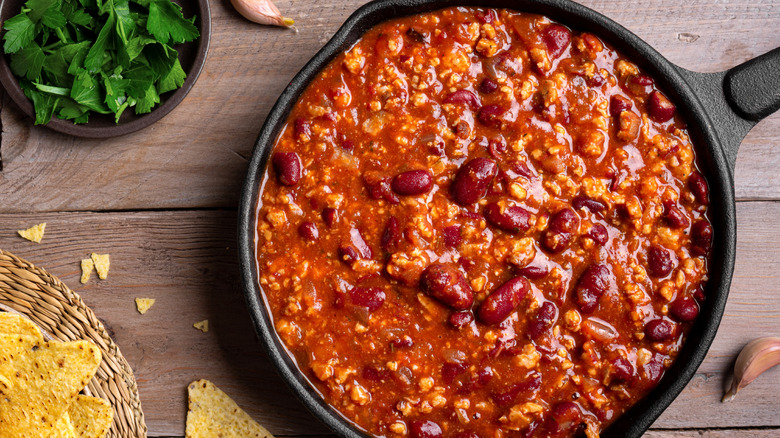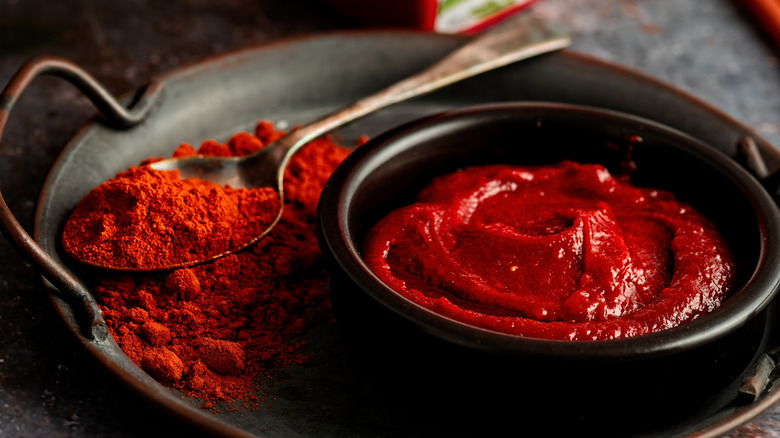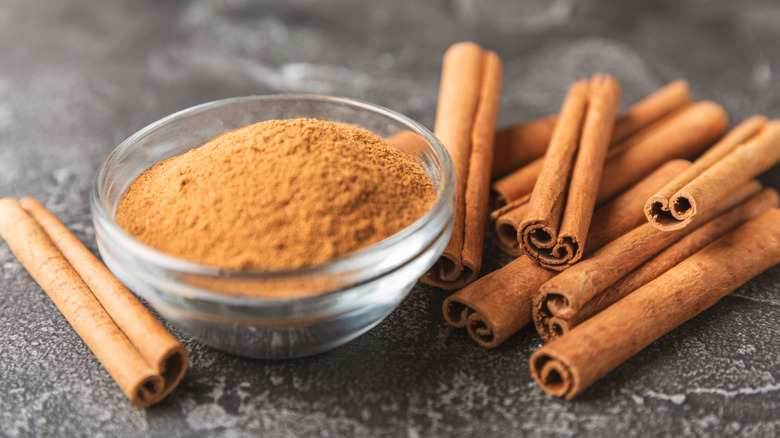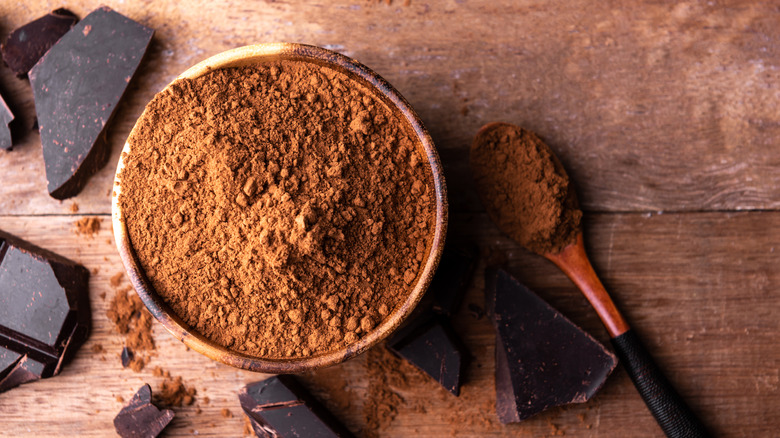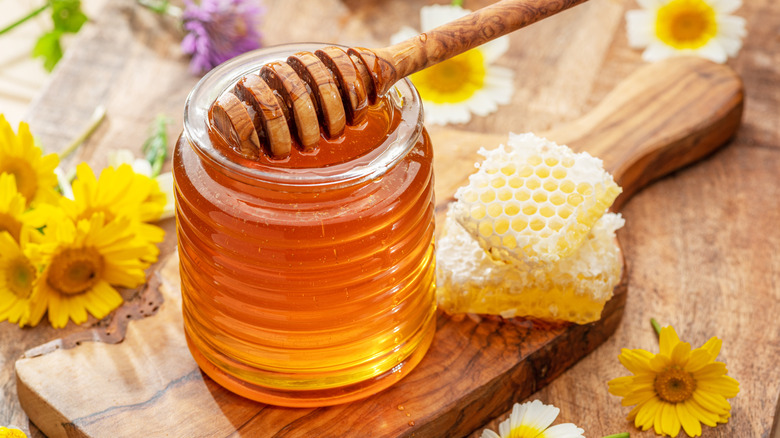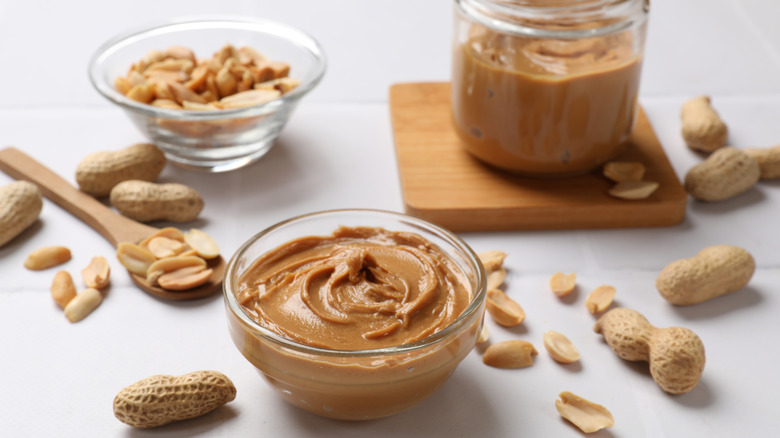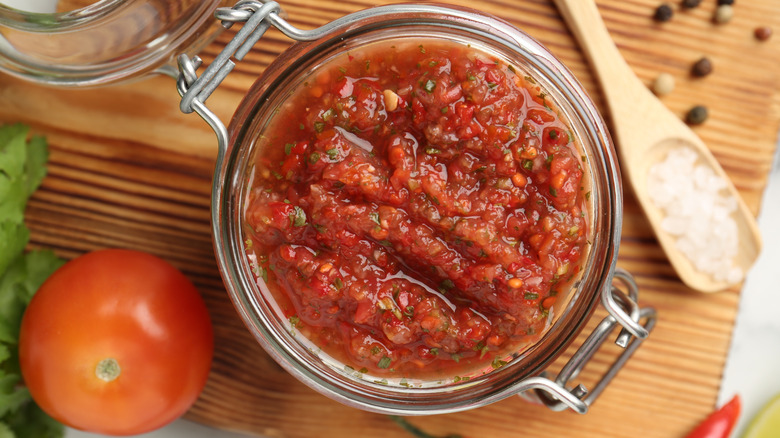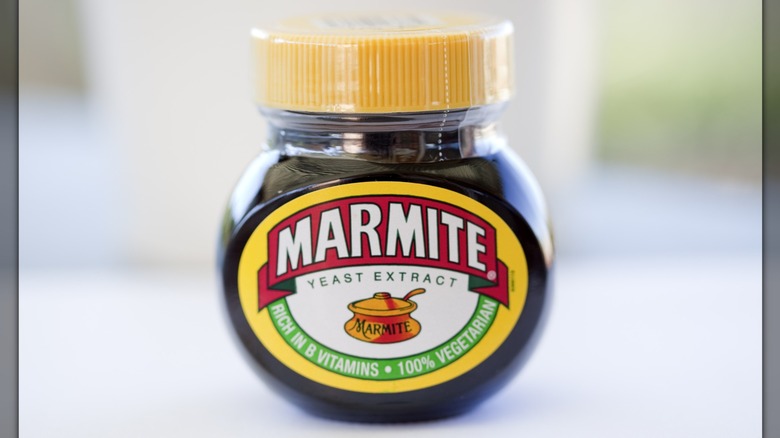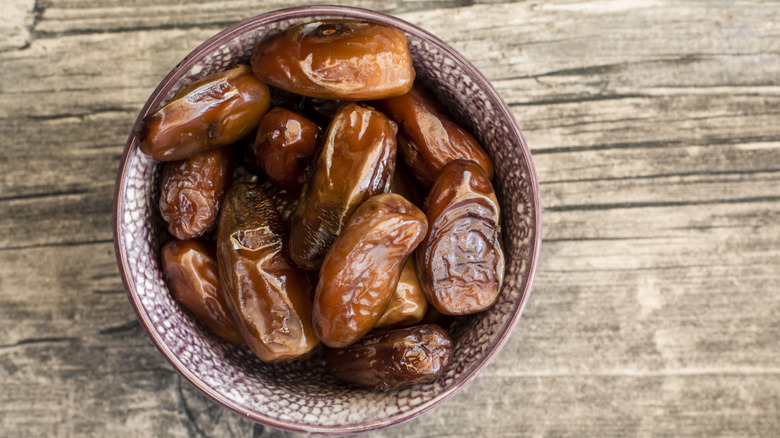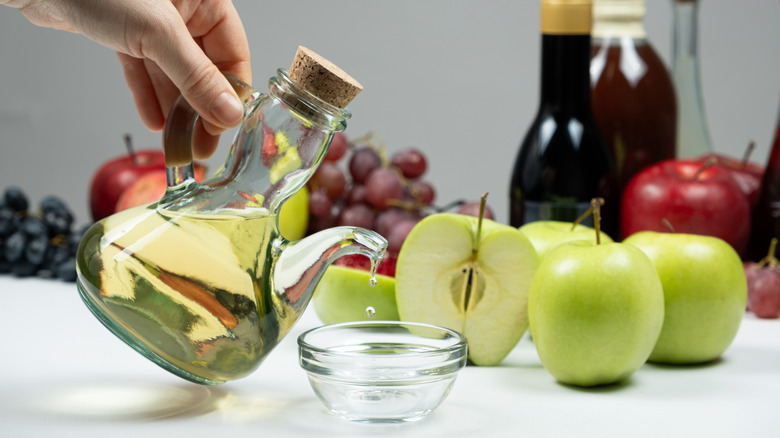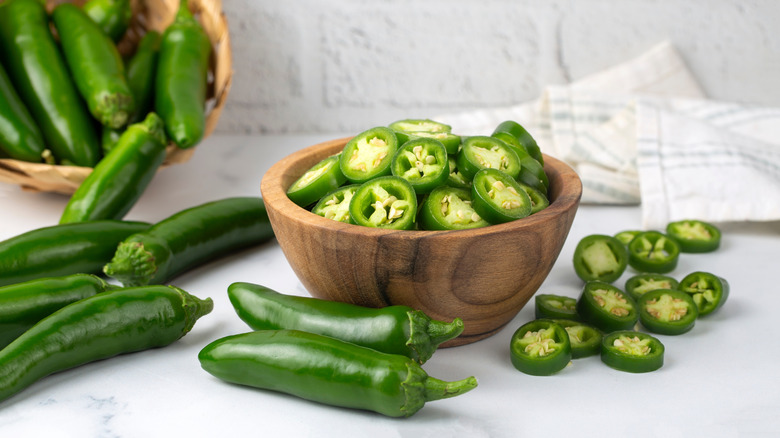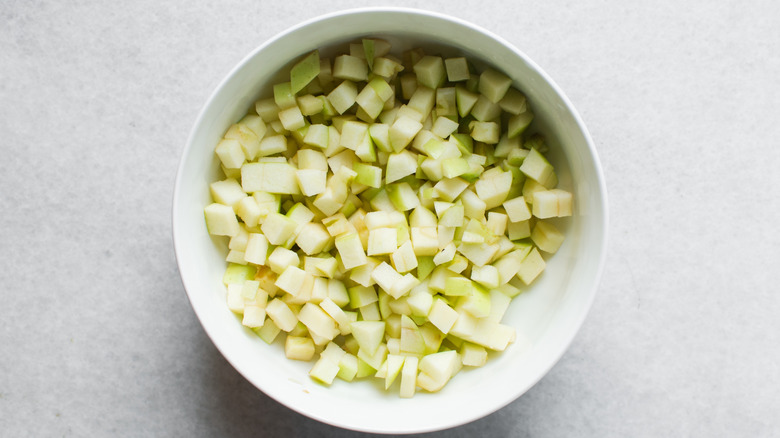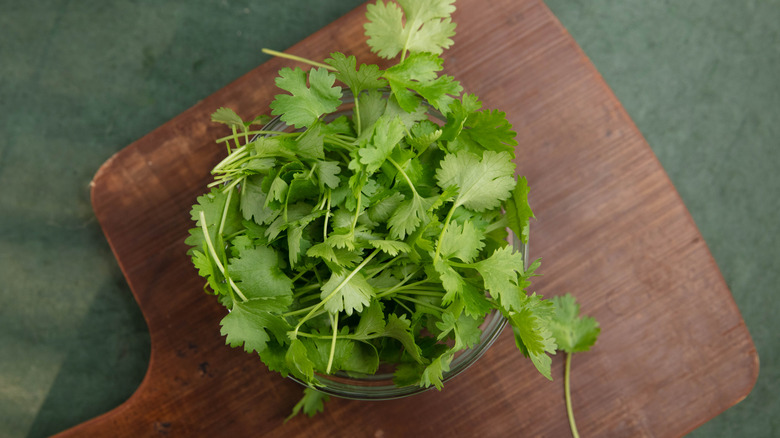17 Ingredients You Should Be Adding To Your Chili
What's the best chili you've ever tasted? For some, a specific dish instantly comes to mind, while others begin to journey down memory lane, reminiscing about all the tasty bowls they've shared with friends and family. Truthfully, it's hard to pick just one favorite recipe because this beloved comfort food is incredibly versatile.
Chili follows a time-honored tradition and according to the International Chili Society, a traditional pot of red consists of meat, red chili peppers, spices, and some veggies. Fillers including beans aren't allowed — which is also the one unbreakable rule of Texas chili. But venture into homestyle territory, and the boundaries expand considerably. Here, you're welcome to mix in beans, seafood, and an array of other ingredients to perfect your pot. Common additions include tomatoes, onions, garlic, cumin, and paprika.
Thinking back to that unforgettable bowl of chili, were there any specific ingredients that made it stand out? If you can't quite put your finger on it, we're not surprised. Many chefs add a personal touch that immediately elevates their chili. And if you're looking to do the same, we have 17 ingredients that can take your chili from mediocre to mouthwatering.
Gochujang
Want to add a Korean twist to that pot of chili? Gochujang is the answer. This Korean condiment is made of fermented soybeans and red pepper powder, resulting in a spicy, umami-packed spread that adds loads of flavor to dishes. In chili, it contributes a rich, savory element, and depending on the brand, it'll bring varying levels of heat along with smokiness.
You can find gochujang in Asian markets, in the international food aisle at major grocery stores, or you can purchase it online. A little bit goes a long way, so start small and adjust to taste. Measurements depend on the size of your pot, but we recommend roughly a tablespoon per 2-3 servings. If you love the flavor, give your pot an extra kick by sprinkling in gochugaru, Korean chili flakes. Add these extra ingredients fairly early so it can blend thoroughly with the broth, tomatoes, and meat.
Cinnamon
Although many associate cinnamon with desserts, it works wonders in savory dishes. Just consider Moroccan chicken pie or certain Indian curries like korma and masala. Italian chef Giada De Laurentiis even adds cinnamon to her carbonara sauce. Ultimately, these dishes wouldn't have that same satisfying flavor without the right combination of spices. We felt the same way after trying cinnamon in chili. This warming spice adds depth and just a subtle sweetness — but unlike the pure intensity of sugar, it has an earthier, spicier element.
Cinnamon is a staple in almost everyone's spice cabinet, and it requires very little effort to add it to recipes. When it's time to add seasonings, sprinkle in about two teaspoons of cinnamon per pot. We wouldn't recommend more than a tablespoon or it'll dominate the dish and may even taste bitter or chalky. If you don't have ground cinnamon on hand, a couple of cinnamon sticks will also do the trick.
Cacao powder or chocolate
Cacao powder in chili might sound funky, but hear us out. Cacao isn't naturally sweet like the hot cocoas and chocolate desserts we're used to. Instead, this pulverized seed is bitter and tastes like the essence of chocolate (sans all the sugar and fat). And the union of cacao and savory dishes is nothing new. According to NBC News, archaeologists in Mexico discovered traces of cacao, which was frequently used in beverages, on plates dating back 2,500 years. It looks like the Mayans used it to season food, too. We imagine this ancient combo may even have paved the way for Mexican mole sauce. Knowing how delicious mole is, we weren't surprised that cacao works beautifully in chili as well.
Use an unsweetened, fresh cacao powder in your chili, adding it simultaneously with other dry seasonings. If your cacao has been sitting in the cupboard for ages, give it a good sniff test ensuring it still maintains that bold, deep chocolate aroma. And if your supply is no longer fresh, bitter chocolate makes an excellent replacement. As one Reddit user explained, "I add baker's chocolate. Everyone thinks I make some of the best chili and I believe it's because of this." Another user shared exactly how much is ideal per pot: "I do 1-2 ounces of unsweetened baking chocolate bar."
Coffee
The invigorating smell of coffee helps us get out of bed in the morning — and it can also entice us to the kitchen for dinner. Aside from its unique flavor, there's a solid reason why you should add coffee to chili. Coffee adds incredible depth and complexity, and its earthiness makes spices pop. So, if your chili tastes a bit lackluster, use coffee to bring out the other flavors.
Chili should be thick, so don't drown it in freshly brewed coffee. Pour a cup of coffee into your chili around the same time as the broth and spices. If you prefer espresso grinds, add about 2 teaspoons per pound of ground meat. Coffee also pairs beautifully with cacao, so don't feel limited to one or the other. Since many of the items on this list complement each other, mix and match to create a flavorful chili.
Bourbon
Bourbon is an American whiskey known for its sweet, oaky flavor. If you've ever sipped on the stuff, you probably picked up on its spiced caramel and vanilla notes. This whiskey is exclusively made in the United States and must contain 51% corn mash and be aged in oak barrels to achieve its signature flavor. But while the drink is delicious on its own — it can be used in many versatile ways, including as a chili enhancer.
Bourbon isn't a typical chili ingredient, but professional chef Ouita Michel feels it should be. In an interview with Vine Pair, she noted, "it adds a lot of very complimentary spice notes to chili. It has cloves, peppercorn, cinnamon, aspects of vanilla, cocoa, coffee, and dry sweet spices ... and they help with the sweetness of the dish." She recommended two methods of using bourbon in chili: to deglaze the pan after the base ingredients have caramelized or add it shortly before serving. The former provides a sweeter flavor while the latter has an invigorating kick.
Brown sugar or honey
Hoping to sweeten the deal with your chili? Brown sugar and honey may be the answer to your culinary prayers. These everyday ingredients are already in most kitchen cupboards, and do a beautiful job of balancing flavors in that chili pot. Brown sugar's molasses notes and honey's floral sweetness also create a nice contrast to chili's savory and spicy elements.
Regardless of which of these sweeteners you use, 2 tablespoons should be enough. Remember, you can always add more, but you can't unsweeten after the fact. Mix it in during the last 20 minutes of cooking after all other spices and seasonings have been added. This way, you can see how it complements the other spices, adding more accordingly. And if you have a heavy hand with those hot peppers or acidic tomatoes, a little extra sugar or honey will tame these elements.
MSG
Monosodium glutamate has gotten a bad rap over the years, but luckily, the public's perception of MSG is shifting — and we couldn't be happier. As Harvard Health explains, normal amounts of MSG aren't linked to negative health effects. And just about anyone who's tried the stuff immediately associates it with delicious-tasting dishes. So, if you want to add it to your chili, go right ahead!
This crystalline flavor enhancer is found in Asian markets or online. Considering it has glutamate in its name, it's no wonder it tastes like concentrated umami, which amplifies those meaty, savory flavors in chili. Ultimately, MSG gives dishes that more-ish quality, so make a big pot! Guests will likely be craving seconds. However, since it increases the saltiness of dishes, we suggest using it as a partial replacement for salt. Swap a third of your salt for MSG and it'll send those mouthwatering signals straight to the brain.
Peanut butter
Elvis wasn't all shook up when he started eating peanut butter with bacon. He was actually onto something because truthfully, this condiment complements many meat dishes, including home-cooked chili. Its velvety texture and nutty depth are welcomed elements and the creaminess can tame an overwhelming spice.
When adding peanut butter to chili, go for natural creamy or crunchy varieties — but skip the sweet stuff unless you want your chili to taste like a candy bar. The creamy version melts seamlessly into the mixture while the nutty version contributes a satisfying crunch. Whichever you choose, add a few tablespoons towards the end of cooking and blend well. Your guests will be stumped as to what the mystery ingredient is. But if there's one thing for certain, they'll be praising your culinary skills with a "Thank you. Thank you very much."
Liquid smoke
Are you craving chili with that campfire quality? There's no need to light a fire outdoors; you can achieve this flavor from the comfort of your home with liquid smoke. This unique condiment is exactly as it sounds: wood is burned and the smoke is channeled through water before being bottled as a mouthwatering sauce.
When poured over meals, liquid smoke adds that 'cooked all day' quality. But remember, less is more when it comes to this smoky sauce. As a Reddit user advised, "It's very, very powerful. A few drops at most. Start with one, stir it in, and taste." They encourage you to continue this process to your desired smoke level, warning that too much will destroy your dish. They also recommend sampling a variety of flavors since liquid smoke can be "Hickory, Oak, Mesquite, etc., and they all taste different," but clarifying that "What most people think of 'smoke' is usually hickory."
Salsa
Tomatoes are already a primary player in many chilis, with many people using tomato paste, diced tomatoes, or freshly chopped ones. But if you want even more of that fresh tomato flavor, add salsa. This popular condiment is a ready-made flavor bomb. With pre-chopped and pre-seasoned vegetables, your work is essentially half done just by opening the jar.
Different sauces bring different personalities to your pot. Roasted varieties enhance the chili's smokiness, salsa verde has a tangy twist, and spicy options bring the heat. And if you're wondering what the difference between pico de gallo and salsa is, it's simple: pico de gallo is made of chopped, raw ingredients while salsa is typically blended. If you want the salsa to be a base flavor, add it towards the beginning of cooking. But if you prefer brighter flavors, add pico de gallo towards the end or as a garnish just before serving.
Marmite or Vegemite
There's nothing quite as polarizing as Marmite and Vegemite. People find these spreads either delightful or disgusting — but nothing in between. And if you're the former, we highly recommend adding it to chili for a salty, yeasty twist.
Marmite and Vegemite hail from the UK and Australia, respectively. These love-it or hate-it spreads are made from a concentrated yeast extract that tastes like umami condensed into a jar. However, since Marmite and Vegemite are packed with glutamates, it can be overwhelming for some. But mixed with meat, chili peppers, and other seasonings, the flavor is far more subdued, so even those who don't enjoy marmite on toast might love it in a bowl of chili. As such, don't be afraid to add a couple of teaspoons of this sticky spread early in the cooking process so the flavors — and that umami goodness — can blend properly.
Dried dates
Dried dates are nature's candy, offering a subtle sweetness and interesting texture to your chili. They're also an excellent choice for those who crave sweetness but avoid processed sugar. And since these dried fruits have pectin — a natural binder – they can help thicken that pot.
How you prepare the dried dates makes all the difference. If you want sweet chewy chunks in your chili, dice the dates into larger pieces and add them in the last 30 minutes of cooking. If you simply want the flavor to blend in, chop finely and they'll dissolve as they cook into the sauce. Finally, you can toss them in whole to let the stew absorb the flavors. Just remember to remove them before serving (and keep count of how many you used), or those pits may lead to a dental disaster.
Brine or vinegar
As you stir your chili and let it simmer, take a bite to see what's missing. If the flavor is falling flat, but you're not sure why, we have the perfect solution: brine or vinegar. These acidic conditions wake up the other ingredients in your pot. And depending on the type of brine or vinegar, you may get a burst of flavor along with it.
You likely already have brine or vinegar in your pantry right now. So rummage through those cupboards or fridge to see what you can use, whether it be that leftover juice from your pickle jar or the vinegar you typically use to clean. Bear in mind that the acid you choose will impact the overall dish. On Reddit, a home cook asked what acid they should use in chili and received a detailed response: "Red wine vinegar won't add anything to the flavor to speak of, beyond the acidity, and that may be fine. Apple cider or sherry vinegar would be my next two choices, I'd probably go with sherry for the slight smokiness in addition to acidity."
Jalapeños
Jalapeños are a Goldilocks-approved chili addition. Their moderate heat won't have you chugging milk in pain, but they'll provide just enough kick to liven those taste buds. To spread the heat evenly, use finely diced jalapeños. For a more startling surprise, chop them into larger chunks. Meanwhile, removing the seeds will lessen the spice. So if you want a strong fire, chop the peppers — seeds and all — and toss them straight in.
While we've discussed flavor and texture enhancements thoroughly, we're missing one very important part of chili: presentation. If we're being honest, chili isn't the prettiest of dishes on its own. But just because it's considered a comfort food doesn't mean we can't wrap it up in a pretty bow! In other words, a carefully sliced jalapeño garnish. Prior to serving, sprinkle jalapeño rings in the center of each bowl. That bright green hue will pop against the red chili.
Beer
Beer isn't just a delicious accompaniment to chili; it's a delicious ingredient in it! It delivers a depth of flavor that's unmatched by water or broth alone. And beyond flavor, the alcohol in beer tenderizes the meat by breaking down the proteins.
For every two pounds of meat, we recommend a 16-ounce bottle, adding at least an hour before serving to let the flavors work their magic. If you're avoiding alcohol, non-alcoholic beer is a great substitute, or simply simmer your chili longer. According to Idaho State University, stews that simmered for two and half hours only retained 5 percent of their alcohol, which is fairly low considering the beer is dispersed through a giant pot.
Mind you, the beer you choose will significantly affect the final product. People have discovered that malty beers like red ale add a hint of sweetness while hops make those peppers pop. Meanwhile, certain stouts lend rich, chocolatey notes and brown ales can add a nutty flavor. It all comes down to personal preference, so experiment until you find a beer-illiant option!
Diced apples
During apple season, you'll want to take advantage of this ripe fruit by adding it to your chili. Its natural sweetness is a pleasant contrast to the chili's savory notes, while the acidity helps cut through heavier meats. Plus, apples are a great way to balance the chili's fieriness without detracting from the other flavors.
For chili, we recommend using slightly tart apples like Granny Smith, Braeburn, or Cortland. Although we love biting into these fresh apple varieties, we wouldn't toss raw chunks into our chili. Instead, let the diced apples join your pot after the onions and meat have been browned, giving them time to sauté and mingle with the existing flavors. This gentle cooking transforms the fruit, coaxing out its natural sweetness through caramelization while creating the perfect tender-yet-crunchy texture.
Fresh parsley or cilantro
Now, you have plenty of ways to enhance your chili with tasty ingredients! However, don't forget about the cherry on top — as in, the garnish! Often overlooked by home cooks, these final touches are essential for creating a beautiful finished product. And in the case of fresh herbs, like parsley and cilantro, they're not just pretty; they add a burst of vibrant flavor that cuts through the richness of chili.
Cilantro is one of the most popular yet divisive herbs, with many claiming it tastes like soap. Assuming you're among those who enjoy it, expect a bright citrusy flavor. Parsley, on the other hand, offers more peppery notes. Just before serving, complete your chili with toppings like melted cheese or a dollop of sour cream. Then, of course, garnish it with a generous sprinkle of fresh herbs. Bon appétit!
